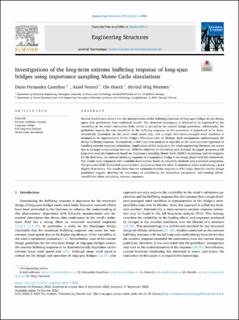| dc.contributor.author | Fernandez Castellon, Dario Rafael | |
| dc.contributor.author | Fenerci, Aksel | |
| dc.contributor.author | Øiseth, Ole Andre | |
| dc.contributor.author | Petersen, Øyvind Wiig | |
| dc.date.accessioned | 2023-02-22T11:46:02Z | |
| dc.date.available | 2023-02-22T11:46:02Z | |
| dc.date.created | 2022-10-28T13:41:53Z | |
| dc.date.issued | 2022 | |
| dc.identifier.citation | Engineering structures. 2022, 273 . | en_US |
| dc.identifier.issn | 0141-0296 | |
| dc.identifier.uri | https://hdl.handle.net/11250/3053219 | |
| dc.description.abstract | Several studies have shown that site measurements of the buffeting responses of long-span bridges do not always agree with predictions from analytical models. The observed discrepancy is believed to be explained by the variability in the wind’s turbulence field, which is ignored in the current design guidelines. Additionally, the guidelines neglect the true variability in the buffeting response, as this parameter is considered to be deterministically dependent on the mean wind speed only, and a single short-term-averaged wind condition is assumed to be representative of the bridge’s behaviour over its lifetime. Such assumptions underestimate the design buffeting response. Alternatively, a full long-term analysis is regarded as the most accurate approach to handling extreme response estimations. Applications of this analysis in the wind engineering literature are scarce due to its large computational demand. With the objective of alleviating such demand, this paper proposes a full long-term analysis framework based on importance sampling Monte Carlo (ISMC) simulations and investigates, for the first time, the extreme buffeting response of a suspension bridge in its design phase with this framework. The results were compared with available formulations based on reliability methods and numerical integration. The proposed ISMC framework requires fewer simulations than the other formulations while maintaining a good degree of accuracy. The results show that the estimated extreme response is 30% larger than the current design guidelines suggest, showing the importance of considering the turbulence parameters' and loading effects' variabilities when calculating extreme responses. | en_US |
| dc.language.iso | eng | en_US |
| dc.publisher | Elsevier | en_US |
| dc.rights | Navngivelse 4.0 Internasjonal | * |
| dc.rights.uri | http://creativecommons.org/licenses/by/4.0/deed.no | * |
| dc.title | Investigations of the long-term extreme buffeting response of long-span bridges using importance sampling Monte Carlo simulations | en_US |
| dc.title.alternative | Investigations of the long-term extreme buffeting response of long-span bridges using importance sampling Monte Carlo simulations | en_US |
| dc.type | Peer reviewed | en_US |
| dc.type | Journal article | en_US |
| dc.description.version | publishedVersion | en_US |
| dc.source.pagenumber | 19 | en_US |
| dc.source.volume | 273 | en_US |
| dc.source.journal | Engineering structures | en_US |
| dc.identifier.doi | 10.1016/j.engstruct.2022.114986 | |
| dc.identifier.cristin | 2066079 | |
| cristin.ispublished | true | |
| cristin.fulltext | original | |
| cristin.qualitycode | 2 | |

